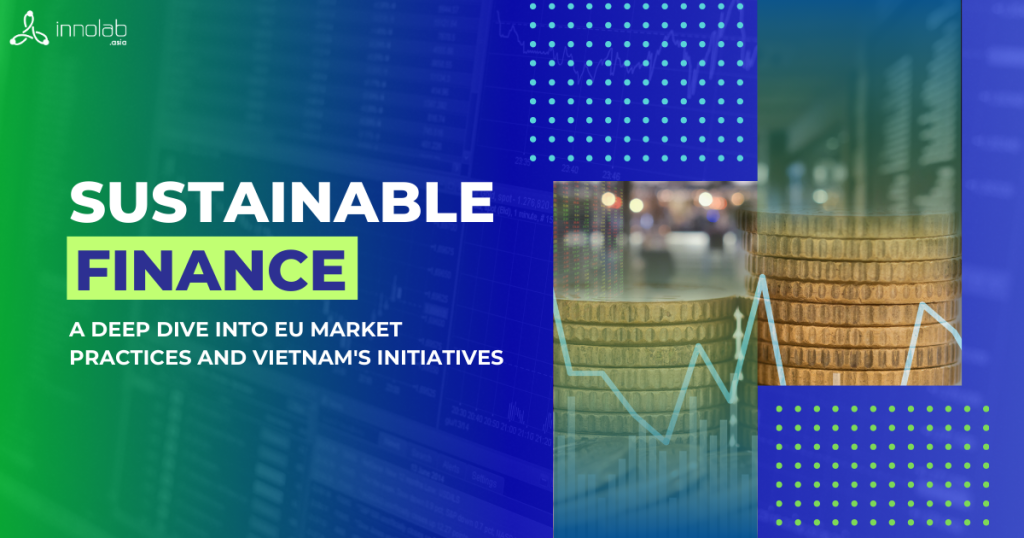Green finance remains pivotal in addressing global climate challenges. Increased investment in environmentally responsible activities and avoidance of harmful practices bring us closer to a sustainable economy. The EU Taxonomy and broader sustainable finance framework aid entities in crafting transition plans and strategies for achieving net-zero emissions by 2050. (European Commission, 2024)
Unveiling the EU Taxonomy’s role, this article highlights key sectors and global perspective, discovers how Vietnam is committed to green finance and a concise overview of the dynamic world of sustainable finance awaits.
The report, “A Compendium of Market Practices” examines early adoption by seven stakeholder groups, emphasizing potential benefits without prescribing best practices or market standards. Despite acknowledging data and implementation challenges, the EU Taxonomy and sustainable finance framework offer advantages to stakeholders.
EU Taxonomy and the impact on 7 stakeholder groups
For Corporates:
The value of EU Taxonomy Key Performance Indicators (KPIs) is evident, with 600 out of 1,700 companies integrating them into financial and transition plans. These KPIs, along with the EU Green Bond Standard, bolster sustainability claims and improve comparability.
For Credit institutions
Credit institutions include the EU Taxonomy in their lending strategies, evaluating clients’ transition readiness through CapEx plans. 711 companies reported an average CapEx alignment of 18%. The EU Taxonomy is now part of ESG risk management and credit decisions, offering potential benefits like improved pricing conditions or enhanced access to finance.

For Investors:
Investors employ EU sustainable finance tools to evaluate companies’ alignment with net-zero targets and enhance shareholder engagement. The EU sustainable finance framework complements voluntary industry guidance, shaping and assessing sustainability in investment products. This is driven by the Sustainable Finance Disclosure Regulation (SFDR), with 56% of total EU assets disclosing under the regulation.
For Insurers:
6.5% of total EU corporate bond issuances in 2023 were green, the EU Taxonomy is also being incorporated into new green non-life insurance solutions, providing incentives for insurers adapting to climate change. It serves as a useful tool, enhancing stakeholder understanding and increasing comparability in insurance solutions.
For Consultants and auditors
Auditors note a shift in companies’ mindset due to the EU Taxonomy, moving from broad sustainability commitments to specific, measurable, and financially defined Key Performance Indicators (KPIs). Clients involve auditors earlier in assurance processes, aligning approaches and preparing data in an auditable manner.
For Public sector:
Public entities issued over 40% of EU green bonds with assurance, and 90% of them cited the EU Taxonomy. Recognized as best practice for classification and reporting, it is increasingly sought by investors. Public issuers are voluntarily aligning bond allocations with the EU Taxonomy.
For SMEs:
Around 10% of SMEs (80% of listed SMEs) secured green/sustainability-linked loans. Taxonomy disclosures can sharpen management focus on sustainability, raise awareness of green finance, and enhance SMEs’ access to private capital and lending opportunities.
The green transition to global investment landscape
On February 2nd, a representative from InnoLab Asia participated in The EU Sustainable Investment Summit 2024 held in Brussels. The summit provided key insights and the latest perspectives on the prospects of the green transition, emphasizing the themes of “Make it new with innovation as a driver”, “Make it happen towards a net-zero economy”, and “Make it global by sharing the transition effort in a fair way”.
It began in 2021 following the launch of the European Green Deal, which sets the objective for Europe to become the first climate-neutral continent by 2050, and the European Green Deal Investment Plan, which aims to unlock the investments and finance needed to achieve this goal.

Jim Skea, Chair of the Intergovernmental Panel on Climate Change (IPCC) in his keynote speech mentioned that most climate investment is focused on climate change mitigation and not on adaptation. The upcoming cycle of IPCC focus will be steered toward climate change adaptation.
Furthermore, Gauri Singh, Deputy Director-General, International Renewable Energy Agency, observed three groups of countries in their approach to the green transition.
- Group 1, exemplified by the EU, advocates for the economy to lead the transition.
- Group 2 comprises emerging economies seeking more green energy to advance
- Group 3, representing underdeveloped countries, approaches the transition cautiously, considering it an opportunity when coupled with development. Countries in this third group are progressing at a slower pace in their transition efforts.
Sustainable finance in Vietnam
In the present context, Vietnam is increasingly prioritizing environmental concerns and addressing climate change. The government has recognized the development of green finance in Vietnam as a crucial direction to mobilize capital for the green economy, displaying a strong commitment to achieving a “zero” greenhouse gas emissions economy by 2050, as pledged at COP26.
According to the National Green Growth Strategy for 2021-2030 and the vision towards 2050 (No. 1658/QD-TTg) (Báo Chính Phủ, 2021), the targets for 2050 include reducing greenhouse gas emissions intensity per unit of GDP by at least 30% compared to 2014, achieving a Human Development Index (HDI) exceeding 0.8, and ensuring that at least 90% of the population uses sanitized water meeting the Ministry of Health’s regulations.

To stimulate the growth of the green bond market, the Ministry of Finance (MoF) has issued a circular, directing green bond issuers and investors to benefit from a 50% discount on the service price of green bonds on the stock market. (Báo Chính Phủ, 2021)
Additionally, the establishment of the Just Energy Transition Partnerships in Indonesia and Vietnam aims to facilitate increased financing for the transition towards a net-zero future. With an initial investment of USD 15.5 billion earmarked for transitioning Vietnam’s energy sector, the government is also dedicated to enhancing the country’s green finance legal framework. This commitment is geared towards fostering greater interest and engagement in the field of sustainable finance. (VietnamPlus, 2023)
Vietnam’s Latest Sustainable Finance Updates:
Many start-ups in Vietnam integrate sustainable development goals into operations. 85% of surveyed Vietnamese businesses have fully or partially integrated Sustainable Development Goals (SDGs) into their operations, particularly in technology, communications, e-commerce, AI, and blockchain sectors. (VietnamPlus, 2024)
Vietnam aims to establish a comprehensive carbon credit market, aligning with global policies to address climate change and reduce greenhouse gas emissions. This initiative is expected to generate green financial resources for technological innovation. (Vietnam News, 2024)
Vietnam’s forestry sector achieved a milestone in 2023 by selling 10.3 million forest carbon credits for US$51.5 million through the World Bank. With vast forest resources, Vietnam can capitalize on the carbon credit market to reinvest in forest protection and development.(VietNamNet News, 2024)
Challenge-Recommendation Framework for Vietnam’s Sustainable Finance Ecosystem
Despite initial steps by the government and businesses to promote sustainable finance in Vietnam, significant challenges remain, not only for Vietnam but also for ASEAN countries. To strengthen the country’s sustainable finance ecosystem, the EU-ASEAN Business Council recommends addressing six key challenges (Energy Transition in ASEAN, 2023). These include developing an ASEAN-specific Energy Transition Mechanism, increasing Public Policy Derisking Instruments, adopting Financial De Risking Instruments, enhancing the ASEAN-wide green finance taxonomy, implementing a sustainable infrastructure labeling system, and supporting government-led carbon pricing mechanisms. These efforts aim to align energy and climate policies, encourage investment in low-carbon technology and infrastructure, and promote economically viable renewable energy projects in ASEAN member states.
In conclusion
Our exploration of sustainable finance in the Platform’s Market Practices Compendium emphasizes the pivotal role of green initiatives globally. The EU Taxonomy and sustainable finance framework guide entities toward achieving net-zero emissions by 2050. Stakeholders, including corporates, credit institutions, investors, insurers, consultants, and the public sector, actively contribute to the green transition.
Insights from The EU Sustainable Investment Summit 2024 and Vietnam’s latest green finance news align with global commitments to innovation and net-zero economies. In addition, Vietnam’s dedication to green finance, with a “zero” emissions goal and specific targets, reflects this global trend. This concise overview provides actionable insights and recommendations for navigating the dynamic landscape of green finance.
References:
European Commission (2024). Sustainable finance: a dive into the Platform’s Compendium of market practices. [online] Available at: https://finance.ec.europa.eu/system/files/2024-01/240129-sf-platform-report-factsheet_en.pdf.
Báo Chính Phủ (2021). National Green Growth Strategy for 2021-2030, vision towards 2050. [online] Báo Chính Phủ. Available at: https://en.baochinhphu.vn/national-green-growth-strategy-for-2021-2030-vision-towards-2050-11142515.htm.
VietnamPlus (2023). Vietnam improving legal framework to attract green finance, green technology | Environment | Vietnam+ (VietnamPlus). [online] VietnamPlus. Available at: https://en.vietnamplus.vn/vietnam-improving-legal-framework-to-attract-green-finance-green-technology/247181.vnp.
VietNamNet News. (2024). VietnamNet. [online] Available at: https://vietnamnet.vn/en/vietnam-has-great-potential-in-development-of-carbon-credit-market-2239783.html
VietnamPlus (2024). Many start-ups integrate sustainable development goals into operations | Business | Vietnam+ (VietnamPlus). [online] VietnamPlus. Available at: https://en.vietnamplus.vn/many-startups-integrate-sustainable-development-goals-into-operations/275842.vnp
Vietnam News (2024). Việt Nam to develop synchronous and comprehensive carbon credit market: Deputy PM. [online] vietnamnews.vn. Available at: https://vietnamnews.vn/environment/1638991/viet-nam-to-develop-synchronous-and-comprehensive-carbon-credit-market-deputy-pm.html
Energy Transition in ASEAN. (2023). Available at: https://eurochamvn.org/wp-content/uploads/2023/12/Jan-2023_Energy-Transition-in-ASEAN_GGSC.pdf
stay connected with innolab asia
Sign-up and get more Business & Innovation reports & insights from us



